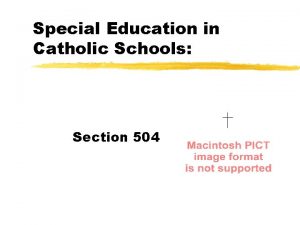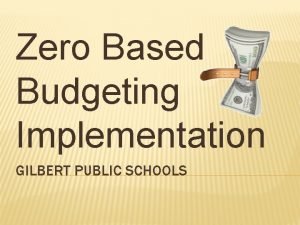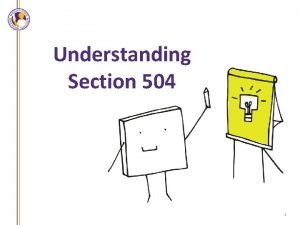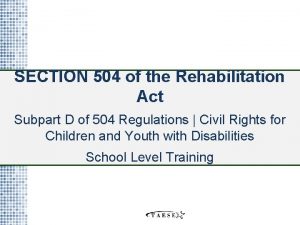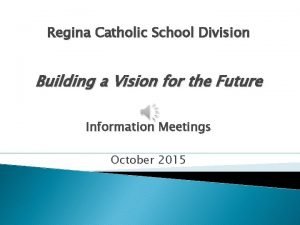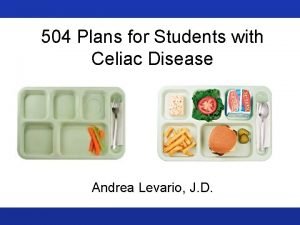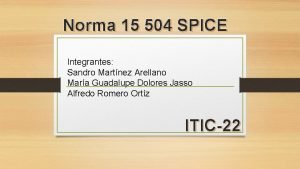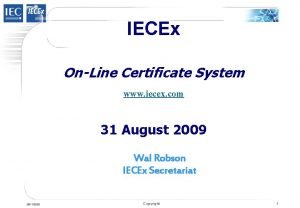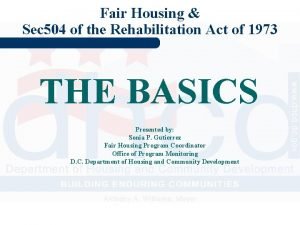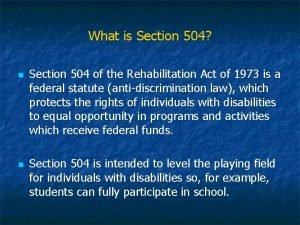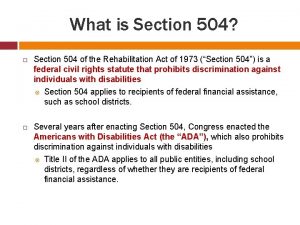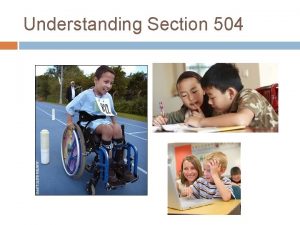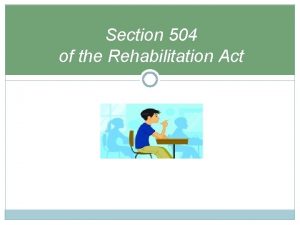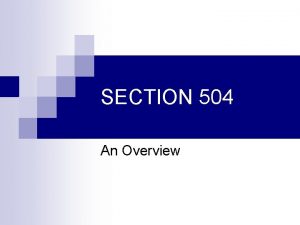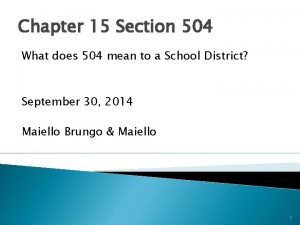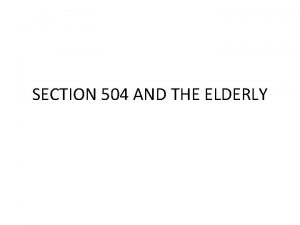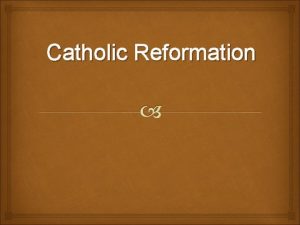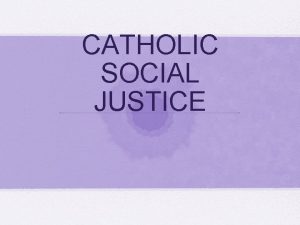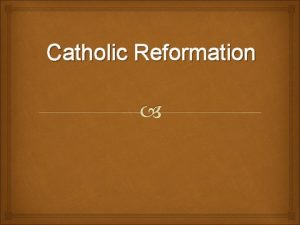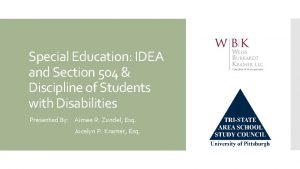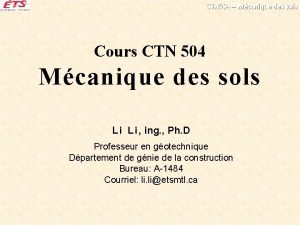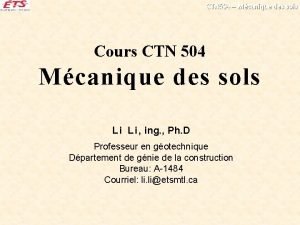Special Education in Catholic Schools Section 504 Federal





















- Slides: 21

Special Education in Catholic Schools: Section 504

Federal Laws z 1. Individuals with Disabilities Education Act (IDEA)-does not apply directly to Catholic schools z 2. Americans with Disabilities Act (ADA)part of Civil Rights Act; specific exemption of Catholic schools z 3. Section 504 of the Rehabilitation Act of 1973; no exemption for Catholic schools.

Section 504 z. Nondiscrimination statute; Office of Civil Rights. z. Does require that institution receive federal funds z. No exemption for religious schools z. Originally to protect veterans z. Protects under 460 disabilities!

Purpose: z“to ensure that handicapped individuals not be denied jobs or other benefits because of the prejudice, attitudes, or ignorance of others. ” z. Demands that schools undertake programs for faculty and staff concerning in what manner ‘reasonable accommodation’ will be adopted.

Definitions z 1973: “No other wise qualified handicapped individual. . Shall solely by reason of his handicap, be excluded from participation in, be denied the benefits of, or be subjected to discrimination under any program or activity receiving federal financial assistance. ” z 1974: included “physically or mentally handicapped children who may be denied admission to federally supported school systems on the basis of their handicap. ” z 1979 Office of Civil Rights to administer

Definitions of disability: z 1. Physical impairments which substantially limit one or more major life activities; e. g. AIDS, ADHD, Tourette’s z 2. Those with a history…e. g. misclassified z 3. Those without a significant impairment but are treated as such, impaired by attitudes, appears as having impairment. e. g. AIDS, Hepatitis B z. Excludes those using illegal drugs

“any program receiving federal assistance” z z z Free/reduced lunch Federal milk Federal energy grants ESEA Any Title Program Telecommunications grant

Student Eligibility z z z Communicable diseases Temporary disabilities e. g. accidents Allergies or asthma Drug or alcohol addicted (if they are not currently using illegal drugs) Environmental illnesses Parents with disabilities

Private school obligation z More limited in nonpublic z Range not as extensive as in public schools z Private schools are considered providers of ‘other services’ z Private schools may establish eligibility requirements that are more selective than merely being of age and ability to pay. z All must: y Furnish least restrictive environment and comparable facilities; y Equal opportunity to participate in extracurriculars and counseling

When you advertise, remember: Private schools offering special education programs must offer the same advantages as public schools

Types of disabilities z. Physiological (obvious) z. Mental or psychological z. Hidden (e. g. diseases)no requirement for active z. Chronic (e. g. diabetes)screening z. Exceptions: y. Environmental y. Cultural x. Homosexuality, transvestism, kleptomania, pyromania y. Economic

Accommodations z. Catholic schools: “minor adjustments” y. Related aids and services y. Obligation to continue to make adjustments y. May need to modify code of discipline, standards for expulsion y. Need to train teachers

“Minor adjustments”: z Journal to communicate with parents z Duplicate set of tests z Allow more time for change of class z Allow more time for tests z Vary instructional materials z Deal with menu changes in cafeteria z Change student’s seat z Network with student’s other teachers

“Nonminor adjustments” z. Establishment of a new program z. Hiring additional personnel z. Persistent disruption of classroom z. Significant use of a teacher’s time z. Putting others’ health, safety at risk

Special Education in Catholic Schools: Individuals with Disabilities Education Act (IDEA) 1990

Purpose and Implications z. To insure a free appropriate public education in least restrictive environment z. Requires LEA to provide special ed to students w/disabilities in parochial schools z. LEA must initiate and conduct meetings to develop, review, and revise IEP. z. LEA must provide genuine opportunity for equitable participation in program benefits.

Equitable Program of Benefits z. LEA must: y. Consult with reps of private school; y. Consider which student will receive benefits; y. How the students’ needs will be identified; y. What benefits will be provided; y. How the benefit will be provided; y. How the program will be evaluated.

Major concern: z. How the benefits will be delivered y. Establishment clause; Lemon Test y. Aguilar v. Felton (1985) y. Must private school students be provided with the same level of services as P. S. ? y. Are LEA’s required to provide on-site services?

Landmark Cases z. Zobrest (1993) z. Kiryas Joel (1994) z. Agostini (1997) z. Russman (1997)

1997 Amendments z. LEA may provide on-site services; not required: z. LEA need not spend more on private school services than public school for same services; z. May spend to the amount as if the child were in public school.

Remember: We need teachers more in the classroom than in the courtroom.
 504 plan catholic schools
504 plan catholic schools Gilbert public schools special education
Gilbert public schools special education Single family housing section 504 repair pilot program
Single family housing section 504 repair pilot program Section 504 home repair program
Section 504 home repair program Section 504
Section 504 Sba section 504 loan program
Sba section 504 loan program Section 504
Section 504 Deshaye catholic school
Deshaye catholic school Powerschool huntsville
Powerschool huntsville Reach schools safety schools and
Reach schools safety schools and Trgs 504
Trgs 504 Idea vs 504
Idea vs 504 Factorizacion prima de 360
Factorizacion prima de 360 504 plan oklahoma
504 plan oklahoma Celiac 504 plan
Celiac 504 plan Blink htlm
Blink htlm Manifestation meeting for 504
Manifestation meeting for 504 Norma 504
Norma 504 Iecex od 504
Iecex od 504 Sec 504
Sec 504 Special schools north tyneside
Special schools north tyneside Roche center
Roche center
